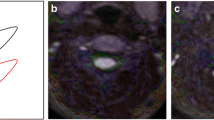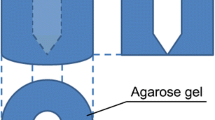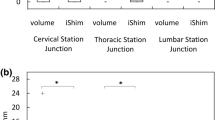Abstract
Objective
Our objective was to compare available techniques reducing artifacts in echo planar imaging (EPI)-based diffusion-weighed magnetic resonance imaging MRI (DWI) of the neck at 3 Tesla caused by B0-field inhomogeneities.
Materials and methods
A cylindrical fat–water phantom was equipped with a Maxwell coil allowing for additional linear B0-field variations in z-direction. The effect of increasing strength of this superimposed gradient on image quality was observed using a standard single-shot EPI-based DWI sequence (sEPI), a zoomed single-shot EPI sequence (zEPI), a readout-segmented EPI sequence (rsEPI), and an sEPI sequence with integrated dynamic shimming (intEPI) on a 3-Tesla system. Additionally, ten volunteers were examined over the neck region using these techniques. Image quality was assessed by two radiologists. Scan durations were recorded.
Results
With increasing strength of the external gradient, marked distortions, signal loss, and failure of fat suppression were observed using sEPI, zEPI, and rsEPI. These artifacts were markedly reduced using intEPI. Significantly better in vivo image quality was also observed using intEPI compared with the other techniques. Scan time of intEPI was similar to sEPI and zEPI and shorter than rsEPI.
Conclusion
The use of integrated 2D shim and frequency adjustment for EPI-based DWI results in a significant improvement in image quality of the head/neck region at 3 Tesla. Combining integrated shimming with rsEPI or zEPI can be expected to provide additional improvements.





Similar content being viewed by others
References
Padhani AR, Koh DM, Collins DJ (2011) Whole-body diffusion-weighted MR imaging in cancer: current status and research directions. Radiology 261(3):700–718
Fung SH, Roccatagliata L, Gonzalez RG, Schaefer PW (2011) MR diffusion imaging in ischemic stroke. Neuroimaging Clin N Am 21(2):345–377
Thoeny HC, De Keyzer F, King AD (2012) Diffusion-weighted MR imaging in the head and neck. Radiology 263(1):19–32
Filipe JP, Curvo-Semedo L, Casalta-Lopes J, Marques MC, Caseiro-Alves F (2013) Diffusion-weighted imaging of the liver: usefulness of ADC values in the differential diagnosis of focal lesions and effect of ROI methods on ADC measurements. Magn Reson Mater Phy 26(3):303–312
Skare S, Newbould RD, Clayton DB, Albers GW, Nagle S, Bammer R (2007) Clinical multishot DW-EPI through parallel imaging with considerations of susceptibility, motion, and noise. Magn Reson Med 57(5):881–890
Ahlhelm F, Hagen T, Schneider G, Dorenbeck U, Nabhan A, Reith W (2004) ADC mapping of normal human brain. Med Sci Monit 10(11):MT121–M125
Yoshikawa T, Kawamitsu H, Mitchell DG, Ohno Y, Ku Y, Seo Y, Fujii M, Sugimura K (2006) ADC measurement of abdominal organs and lesions using parallel imaging technique. AJR Am J Roentgenol 187(6):1521–1530
Porter DA, Heidemann RM (2009) High resolution diffusion-weighted imaging using readout-segmented echo-planar imaging, parallel imaging and a two-dimensional navigator-based reacquisition. Magn Reson Med 62(2):468–475
Riffel P, Michaely HJ, Morelli JN, Pfeuffer J, Attenberger UI, Schoenberg SO, Haneder S (2014) Zoomed EPI-DWI of the pancreas using two-dimensional spatially-selective radiofrequency excitation pulses. PLoS One 9(3):e89468
Thierfelder KM, Scherr MK, Notohamiprodjo M, Weiss J, Dietrich O, Mueller-Lisse UG, Pfeuffer J, Nikolaou K, Theisen D (2014) Diffusion-weighted MRI of the prostate: advantages of Zoomed EPI with parallel-transmit-accelerated 2D-selective excitation imaging. Eur Radiol 24(12):3233–3241
Holdsworth SJ, Yeom K, Skare S, Gentles AJ, Barnes PD, Bammer R (2011) Clinical application of readout-segmented- echo-planar imaging for diffusion-weighted imaging in pediatric brain. AJNR Am J Neuroradiol 32(7):1274–1279
Blamire AM, Rothman DL, Nixon T (1996) Dynamic shim updating: a new approach towards optimized whole brain shimming. Magn Reson Med 36(1):159–165
Lee SK, Tan ET, Govenkar A, Hancu I (2014) Dynamic slice-dependent shim and center frequency update in 3 T breast diffusion weighted imaging. Magn Reson Med 71(5):1813–1818
Zhang H, Xue H, Alto S, Hui L, Kannengiesser S, Berthold K, Jin Z (2015) Integrated shimming improves lesion detection in whole-body diffusion-weighted examinations of patients with plasma disorder at 3 T. Invest Radiol 51(5):297–305
Koyasu S, Iima M, Umeoka S, Morisawa N, Porter DA, Ito J, Le Bihan D, Togashi K (2014) The clinical utility of reduced-distortion readout-segmented echo-planar imaging in the head and neck region: initial experience. Eur Radiol 24(12):3088–3096
Schick F, Forster J, Machann J, Huppert P, Claussen CD (1997) Highly selective water and fat imaging applying multislice sequences without sensitivity to B1 field inhomogeneities. Magn Reson Med 38(2):269–274
Barth BK, Cornelius A, Nanz D, Eberli D, Donati OF (2015) Diffusion-weighted imaging of the prostate: image quality and geometric distortion of readout-segmented versus selective-excitation accelerated acquisitions. Invest Radiol 50(11):785–791
Stemmer A, Kiefer B (2015) Combination of integrated slice-specific dynamic shimming and pixel-wise unwarping of residual epi distortions. Proc Intl Soc Mag Reson, Med
Author information
Authors and Affiliations
Corresponding author
Ethics declarations
Conflict of interest
A Stemmer and B Kiefer are employees of Siemens Healthcare GmbH. Beyond that, the authors declare that they have no conflict of interest.
Ethical approval
All procedures performed in studies involving human participants were in accordance with the ethical standards of the institutional research committee and with the 1964 Declaration of Helsinki and its later amendments or comparable ethical standards.
Informed consent
Informed consent was obtained from all study participants.
Rights and permissions
About this article
Cite this article
Gatidis, S., Graf, H., Weiß, J. et al. Diffusion-weighted echo planar MR imaging of the neck at 3 T using integrated shimming: comparison of MR sequence techniques for reducing artifacts caused by magnetic-field inhomogeneities. Magn Reson Mater Phy 30, 57–63 (2017). https://doi.org/10.1007/s10334-016-0582-z
Received:
Revised:
Accepted:
Published:
Issue Date:
DOI: https://doi.org/10.1007/s10334-016-0582-z




